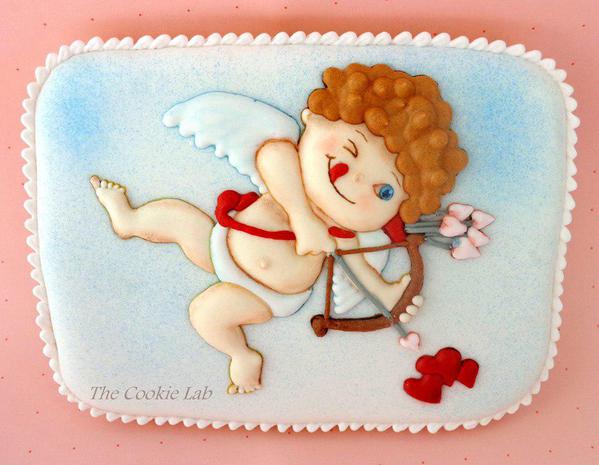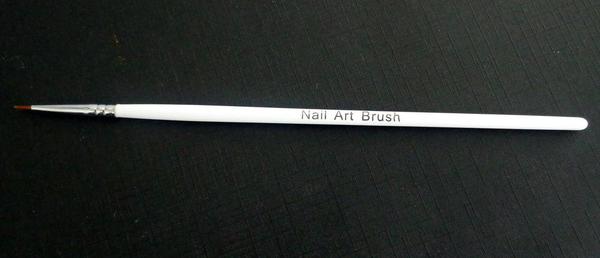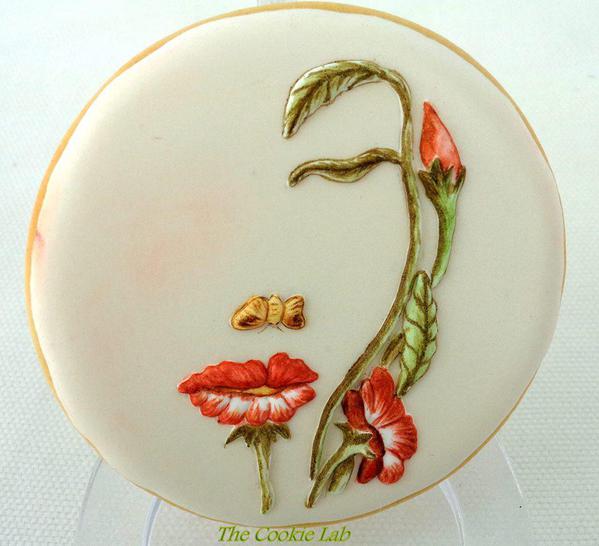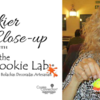It’s hard to believe that the subject of our next Close-up has only been decorating for a little less than three years, but, yes, it’s very true. Marta Torres, aka The Cookie Lab, may be a relative newbie to cookie-land, but she certainly didn’t waste any time dabbling in beginner techniques. In this short time, she instead established a distinctive style; mastered that look; and earned herself a magazine issue dedicated to her work, a Cookiers’ Choice Award nomination, and her cookie colleagues’ deepest respect! (Way to go, Marta!)
If you didn’t get to attend Marta’s recent live chat on Cookie Connection, that’s okay, because you can read the transcript – or, better yet, continue with us here, where we’re going to get even more personal!
![]()
JMU: So, Marta, unlike many of the other cookiers I’ve interviewed, I’ve actually had the good fortune to meet you in person, now twice – first at one of my classes in Portugal and then again this past November at Cookie’sCool. In addition to meeting you, I also got to meet your equally beautiful cookies! I didn’t think they could be any more magnificent than they come across online, but they truly amazed me with their delicacy and intricacy – such tiny, tiny details! I’d like to talk in more depth about how you work on such a small scale, with such obvious finesse, but first, I want to learn more about how you got started on your cookie journey.
What did you do immediately prior to launching into cookies? What prompted you to leave that world and delve so deeply into cookie art?
One of Marta's lovelies that I saw live at Cookie'sCool.
![]()
MT: Hello, Julia. Thank you so much for having invited me [to interview] and for such a nice introduction. Yes, we met twice already, and it’s always a pleasure meeting you.
Let me tell you a little bit about what I’ve been doing; for that, let me go back in time.
In Portugal [EDITOR'S NOTE: Portugal is Marta's home country], I used to work for a bank. It was challenging and I loved it, but due to my husband’s business, we moved to Brazil, then Hong Kong, and finally Japan. All together we stayed abroad for nearly 20 years.
During those years, I worked as freelancer preparing technical manuals in Portuguese for several gadget and equipment [companies], but while in Japan, where I lived for 11 years until returning to Europe, I taught traditional Portuguese cuisine. As I used to entertain very often and people liked my food (everything from bread to amuse bouche, and all in between), I was invited by my embassy to develop a food project with a Japanese association with ties to my country. I was then introduced by a friend to an international cooking school, and I became a teacher there. I also taught several culinary classes at the Tokyo American Club.
By then, my daughter was attending college in the United States, so I used the “excuse” of visiting her to attend the Culinary Institute of America (CIA) to improve my skills. And I became a chef.
But life sometimes changes our paths, and with two week’s notice, I left Japan and returned to Europe on the very last day of 2011. I started in Madrid, where I lived for several months. I was unemployed and had lots of spare time. While there, I saw some cookies made by a male friend, and I decided to take a cookie decorating lesson in one of the several cake shops offering classes. I have to confess that I was disappointed, because wet-on-wet was the technique taught, and it didn’t work for me. Months later, because my husband’s company decided to retire him, we came back to Portugal. It was my daughter who encouraged me to keep going and made me believe that I could make it, so I decided to try it [cookies] again on my own. And, I’ve been practicing ever since!
![]()
JMU: Do you work on cookies full time now? Are cookies a hobby or are they business for you? If the latter, how would you describe your business, meaning how much time do you spend making cookies to sell versus teaching versus doing other cookie-related things?
![]()
MT: Last year, my cookie journey took me to a level that I never though it could. I started receiving invitations for teaching, not just in Portugal, but in Spain and the United States. Some of my followers, from the Philippines to Brazil, started asking if I had plans to go to their countries. So now, YES, this is what I really want to do. Teaching is my passion, with creation and cookie-making in between.
I do sell cookies, but since most of them are very time-consuming, I accept few orders in order to allow time to create and prepare everything for my classes.
I would say that I spend two-thirds of my time creating and teaching and the rest making cookies to sell.
![]()
JMU: You seem to produce one singular cookie work of art at a time rather than working in sets. Why is this? Is this because your cookies are so time-consuming (I know they would take me forever to do), or for some other reason?
![]()
MT: Most of the cookies I’ve been showing are indeed singular pieces - also, my very first attempts of those particular cookies. They are generally full of tiny details and, because their size is really small (8 to 9 centimeters total, with a few exceptions), the details are more challenging and, of course, time-consuming. [EDITOR’S NOTE: That’s 3.1 to 3.5 inches, for you non-metric folks!]
Sometimes I do make less intricate cookies to complement some of my main cookies, but very rarely.
It’s interesting that you asked this question, because I’m presently working on a set of cookies using several techniques, some of them not so common to my decorating style. I’m loving it [the process], and I will show the cookies soon. Besides that, I have another project in which I was invited to participate, and it will probably be shown in March. For this project, I will be using about 40 cookies in just one set. Maybe this is the beginning of more frequent sets. I forecast more for 2015.
![]()
JMU: You have quite a distinctive style, one which I would characterize as “delicately detailed” or centered around “very elegant vignettes” - and one which relies on intricate piping set off by the finest-of-fine handpainted outlines! I could spot your cookies anywhere!
Dancing Girl with Christmas Ornament, another cookie vignette by Marta.
While on the subject of style: I recall you asking me in my class in Portugal if I thought it was important for a cookie artist to have a distinctive style. I found this an interesting question at the time, and so I’m going to turn the tables and pitch it back at you. So . . . has it been important for you to develop this signature style? Why, or why not?
![]()
MT: Thank you so much for characterising my cookies that way. What a nice compliment. There was a time, probably one year ago, when I asked myself that question because all of my cookie idols had very distinctive styles that, as you mentioned, I also could spot at a glance. My style came naturally. I never had the intention of creating one. It was after several other cookie decorators commented on Facebook about my style that I realised I might have one. I think that what I express on my cookies (i.e., my style) is just an expression of my feelings, my exposure to the world, and my preferred surroundings. I don’t think it’s important to develop a style on purpose (I don’t even know if that is possible); it will come naturally. Your own personality, taste, and techniques will be reflected in your cookies, and ultimately, cookie after cookie, they will become your signature style.
![]()
JMU: Why did you gravitate toward this style and set of techniques? What inspired you to take this direction with your cookie art?
![]()
MT: I do like to play with a cookie and give it “life”. Playing with volume, textures, shades, and depth make the figures or elements pop. From the union of piped royal icing elements and final painted details, I get my little edible art pieces. I probably have to “blame” the royal icing for taking me in this direction. As I feel more confident manipulating it, I try to go one step further.
Spreading the Love!
![]()
JMU: And how did you cultivate your style, meaning how did you go from never having decorated a cookie until mid-2012 to being such a proficient cookie decorator? I know you’ve taken some classes . . . I believe a painting class taught by Mensaje en una Galleta was one of your firsts, right? But were there other things you did to build your skills so quickly and expertly?
![]()
MT: The first time that I decorated a cookie, I didn't even know how to make royal icing. I remember mixing some sugar and lemon in a plastic bag, and I ended up with a runny white liquid. Even so, I was happy with it and decorated some gingerbread men cookies to give to my friends. I had no idea there was a wonderful world out there full of decorated cookies.
I recently posted some cookies from that time and couldn't contain my laughing. People reacted in a funny way by saying that there’s still hope for them. LOL!
It was just after leaving Madrid that I tried decorating a cookie again, but I struggled with the royal icing; it wasn't taught in the class that I had attended and I didn't succeed on my own. That's probably why I teach how to prepare royal icing and give lots of tips in my classes.
On my friend’s page on Facebook, I saw he had liked the Mensaje en una Galleta page. So I checked it out, and discovered they were offering online courses. I took one on painting. The class was fantastic; I learned so much, and I fell in love with painting.
But a good royal icing base is needed to achieve the best [painted] results, and mine was quite grainy. The result didn't satisfy me. I tried and tried until I got the recipe I use today. I also searched for information on the Internet to solve some issues I was facing, and my daughter sent me your book from the US. Little by little, with trial and error and practice, I got to the point where I am today, but there is still so much to learn.
When I submitted my cookie for the Cookie Connection Christmas 2013 challenge, I realised that I probably wasn't that bad. LOL! Since then, I´ve been more confident and go for more advanced and challenging works.
In 2014, to complement my skills, I attended your class here in Portugal. I love your work and truly respect it. Last November, I tried hard to go to Genoa to attend classes with some of the best cookie decorators [EDITOR’S NOTE: Marta is referring to Cookie’sCool], and we met again! In 2015, I started challenging myself with other techniques, which I will show soon.
Walking in the Snow.
![]()
JMU: So let’s talk in greater detail about your cookie techniques, using your Walking in the Snow cookie, above, as an example. I think many of us are mystified about how you achieve such detail – so I’m going to try to demystify everything through a series of questions!
Your cookies often feature people or scenes – like I said, “very elegant vignettes” such as the lovely lady above! I had the benefit of seeing her in person, but can you give everyone else a sense of her scale? How big was that cookie?
![]()
MT: This cookie was a pleasure to make. The diameter of the cookie was 9 centimeters (about 3.5 inches) but the girl itself was only 8 centimeters (3.1 inches) tall. The most challenging part of this cookie was, for sure, painting the eyes and the mouth. The face was so small that painting it required a stable hand. I always pray before painting such tiny details. LOL.
![]()
JMU: And what was the source inspiration for that vignette? Was it your original drawing? Or derived from another source? From where do you usually source the images that you cookie?
![]()
MT: The inspiration for this cookie came from an old card. I made some changes and adapted it to my vision and way of decorating. The source inspiration for my cookies can come from everywhere - a painting, music, a book, magazines, fabrics, etc. I also like to take pictures of elements that grab my attention. Presently, I’m working on a set inspired by a book for kids.
I haven’t yet gotten on Pinterest, which seems to be a good source of inspiration as well. Maybe I’ll give it a try.
![]()
JMU: Once you have an image in mind or hand, how do you get that drawing onto your cookies? Do you freehand it? Use a Kopykake? Or use an alternative tracing method? Why do you prefer that approach to some of the others I mentioned?
![]()
MT: I usually draw the design on paper, or re-size the image to the scale I want and print it. Since I don't have a Kopykake, the method used for transferring the drawing (my own or from another source) is selected according to the decoration method chosen. If the cookie is going to be painted, I use food markers and acetate; the tracing will be lighter and easier to cover. But if I use royal icing, I can use either tissue paper or plain paper with food markers.
After my class in Italy with Elizabeth Adams (aka Arty McGoo), I feel more confident drawing freehand directly on a cookie, and I'm willing to challenge myself more and more.
![]()
JMU: Once the image is transferred to the cookie, what’s the next step? Painting the delicate outline that surrounds the image, or piping the icing?
![]()
MT: Even though I usually have an idea about where to start piping, I study the drawing and identify which parts should be done first and the piping sequence. Painting details and the borders is the very last thing.
![]()
JMU: You have several different colors and icing layers on Walking in the Snow. How do you decide which layers/areas to put down first? How do you keep the areas so distinct (i.e., from merging into one another) and crater-free (those tiny areas always seem to crater on me!)?
![]()
MT: As I mentioned above, I study the sequence for applying royal icing for the whole cookie, not for just one color. For this particular cookie, I “dressed” the girl. Everything underneath goes first. If you look at the skirt, it goes under the coat, but over the legs. As for the coat, there are some inner parts showing, therefore, those have to be done first. Those details and the sequence make the difference, giving the cookie both volume and movement.
As for keeping the areas distinct, I rely on the icing consistency and my dehydrator. As I apply royal icing in one area, I let it dry for a couple of minutes before applying it to the next area.
As for avoiding craters, royal icing consistency also plays an important role here. Small spaces don't like royal icing that has too much water; also, I make sure that the entirety of royal icing is touching the cookie surface. These methods have worked for me.
![]()
JMU: And lastly (unless I missed any other key steps), how on earth do you paint such fine lines around the images without any smudging or blobs? Can you tell us what coloring (brand and type) you use as paint? Do you use it straight up or dilute it? If the latter, with what? And, most importantly, what type of brush do you use for such fine work?
![]()
MT: It's interesting that you have asked this question, because there are a lot of factors to consider here. However, the type of color is not the main factor. I use gel, paste, and powder colors, and any brand works, but I do have my favourites: Progel and Americolor for bold painting and Wilton if I want the painting to look like watercolors.
Usually I dilute the colors with water, except for luster dust for which I use alcohol. The amount of added water makes the difference. The angle of the brush is also important and, last but not the least, the brush . . .
I used to get my brushes from any art shop. I used the finest ones I could find for details, until I discovered some brushes at a nail shop and they became my favourites.
I took some with me to my class in the US recently, and there weren't enough for the requests. I hope it works for them as it works for me.
And here's that coveted nail brush!
![]()
JMU: Phew, thanks for that mini cookie lesson! I learned a lot. A couple of final questions. You mentioned earlier that teaching really picked up for you last year. How did your recent class in the US come about? How many classes do you typically teach each year?
![]()
MT: Last year, I taught here in Portugal and Spain, and last December, I taught in the US (Pennsylvania) as I mentioned. I already have some classes scheduled for this year, not just in Portugal, but also in Spain. And I’ll be back in Pennsylvania from July 17 to 19.
In 2014, I taught several classes, but I can’t tell you exactly how many I typically teach, since I’ve only been teaching for a little bit over one year.
The class in the US came up because I was planning to spend Christmas and New Year’s there with my daughter who is a pastry chef. She invited me to teach a local group. When she posted it [the class announcement] on Facebook and her site, I never thought that cookie decorators would travel and stay overnight to attend my class. [EDITOR’S NOTE: But they sure did!] For my 2015 classes in Pennsylvania, I will have one day for beginners and two separate days for advanced level students.
Attending classes is also part of my education. While I may take fewer classes now, there's always something to learn from others!
![]()
JMU: What are some of the biggest lessons you’ve learned from teaching those classes? And could you give our readers more details about your upcoming 2015 classes?
![]()
MT: Even if I teach the same cookies over and over, each class is a challenge, not just technically, but also from the human perspective. Preparation, confidence, and the ability to quickly overcome any problem that may arise are key factors [for a successful class]. I’ve been told that I “give too much” to my classes, but this is how I am.
Marta assisting students in a recent class.
As for more class details: On January 24, I taught in Coimbra, Portugal, and on February 6, I’ll be teaching in Porto de MÓs, Portugal. These two classes have a Valentine’s theme. In March and April, I have three classes scheduled in Spain - in Pamplona, Seville (which is a new city for me), and Barcelona. And I have those July dates in Pennsylvania, as noted above. In between April and July, I will be involved with a collective exhibition here in Portugal. (Unfortunately, I can't disclose further details at present.)
![]()
JMU: That’s terrific – you have quite a line-up of classes already! P.S. Don’t forget to post all of this information on the Cookie Connection calendar, as I’m sure there are many members who will want to partake!
Lastly, the New Year is the time for making resolutions, so . . . what are your top three cookie resolutions for 2015?
![]()
MT: Practice, practice, and practice! LOL! Well, I do have a lot of resolutions, all equally important, but if I have to pick, I’d say these three: incorporate new elements in my cookies, create tutorials, and get a more spacious workspace.
![]()
JMU: Thanks for sharing your story here on Cookie Connection, and best of luck on those resolutions . . . though I’m sure you’ll have no trouble achieving them given your dedication to your cookie art!
My personal favorite from Marta's impressive collection. Original art: "Mouth of Flower" by painter Octavio Ocampo.
All cookies and photos by Marta Torres of The Cookie Lab.
Interested in learning more about Marta? Please visit with her on Facebook at any time!
Interested in getting to know our other Cookiers' Choice Awards nominees? Find links to their Close-ups in our recent finalist announcement here.

Cookier Close-ups is the place on Cookie Connection where we celebrate the change-makers of the cookie decorating world. Whether forging new enterprises, inventing novel decorating techniques, or consistently charming us with their cookie decorating prowess, each of our featured thought leaders has redefined in his/her distinctive way how we interact, create, or otherwise do business here in cookie space!
If there are other cookiers you'd really like to get to know, please post requests in this forum. We'll do our best to round them up for an upcoming Cookier Close-up! Thanks!















Comments (13)